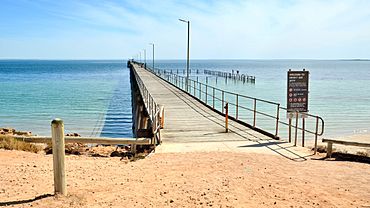Smoky Bay, South Australia facts for kids
Quick facts for kids Smoky BaySouth Australia |
|||||||||||||||
|---|---|---|---|---|---|---|---|---|---|---|---|---|---|---|---|

Smoky Bay Jetty, 2017
|
|||||||||||||||
| Established | 13 November 1913 (town) 28 January 1999 (locality) |
||||||||||||||
| Postcode(s) | 5680 | ||||||||||||||
| Elevation | 1 m (3 ft) | ||||||||||||||
| Time zone | ACST (UTC+9:30) | ||||||||||||||
| • Summer (DST) | ACST (UTC+10:30) | ||||||||||||||
| LGA(s) | District Council of Ceduna | ||||||||||||||
| Region | Eyre Western | ||||||||||||||
| County | Way | ||||||||||||||
| State electorate(s) | Flinders | ||||||||||||||
| Federal Division(s) | Grey | ||||||||||||||
|
|||||||||||||||
| Footnotes | Adjoining localities | ||||||||||||||
Smoky Bay (once called Wallanippie) is a small town in South Australia. It is located on the west coast of the Eyre Peninsula. This town used to be a busy port. Today, it is a quiet place where people live and visit. Many tourists come here for fishing. The town has a boat ramp and a jetty for easy access to the water.
In 2016, about 217 people lived in the town of Smoky Bay.
Contents
History of Smoky Bay
First European Sightings and Settlers
The coastline of Smoky Bay was first seen and mapped in 1802. This was done by a British explorer named Matthew Flinders. He named the bay "Smoky Bay" because he saw a lot of smoke. This smoke came from fires lit by the local Aboriginal people.
The first Europeans to live near Smoky Bay were whalers. They set up camps just north of Point Collinson. Recently, old parts of their camps have been found. These include pieces of whale bone and large cooking pots. These old whaling station remains are now protected as a historic site.
In the early 1860s, farmers who raised sheep arrived. A man named Charles Francis Heath started a sheep farm. He called it Wallanippie Station. This name came from an Aboriginal word for a waterhole nearby.
In 1865, the government decided the area needed more law and order. Charles Francis Heath became the first justice of the peace and local magistrate for Smoky Bay. This meant he helped keep the peace and solve local problems.
Geography of Smoky Bay
The town of Smoky Bay sits on the edge of the bay itself. This bay is north of Streaky Bay. A small piece of land, called Point Brown, protects the bay from big ocean waves. About 10 kilometers offshore, there is a small, sandy island called "Eyre Island." It also helps keep the bay calm.
There are also small, rocky islands made of granite nearby. Many seabirds live on these islands. Tiger snakes also live there and eat the birds. Further west are the Nuyts Archipelago islands, but they are hard to reach.
Inside Smoky Bay, the water is usually calm and shallow. You can find large areas of seagrass, sand, and mudflats. There are also many channels, or "creeks," that boats can use. These channels have slightly deeper water.
Around the bay, you will see different types of plants. To the south, there are mangroves. To the north, there are sand dunes with coastal plants. The mangroves can sometimes make the water look a bit yellow. This is thought to be from natural chemicals called tannins.
The town itself is on a long, sandy beach. This beach ends where the boat ramp is. Away from the coast, the land is used for agricultural farming. Farmers grow crops and raise sheep there.
The bay is home to many different seabirds and fish. Large great white sharks sometimes visit the bay from the offshore islands. Seals also come into the bay, which can attract sharks.
Economy and Tourism
Smoky Bay is no longer a busy port. However, since 1988, it has become famous for growing oysters. This is called aquaculture. There are many oyster farms in the bay. Smoky Bay oysters are well-known in South Australia.
Tourism is also a growing part of the town's economy. There is a caravan park and many beachside holiday homes. Recreational fishing is the biggest reason people visit. The jetty and boat ramp are very busy during summer holidays. Other water sports like swimming and snorkelling are also popular. There is a special shark-proof cage next to the jetty for safe swimming.
You can also take guided tours of the local oyster farms. This is a fun way to learn about the industry.
Community Life
Smoky Bay has about 200 people who live there all the time. In the busy summer months, this number can grow to about 1000 visitors. The town has a small general store. You can sometimes buy petrol and diesel there.
North of the caravan park is a sporting club. It has an oval for sports and tennis courts. The club also serves meals and is open to everyone.
There is one church in town, which belongs to the Uniting denomination. It is across from the caravan park. The town also has a new boat ramp. You need to pay a small fee to the Ceduna Council to use it. The old jetty is still there, but it is shorter now because of storm damage.
A special event called Marilyns Country Music Festival happens every year in Smoky Bay. It is unique because the stage is an oyster barge! This festival is held in September. It brings musicians and visitors from all over Australia.
Getting to Smoky Bay
You can reach Smoky Bay by driving on the Flinders Highway. This highway runs along the coast of the Eyre Peninsula. Stateliner bus services also come to the town. The bus stop is across from the general store.
The Streaky Bay and Ceduna airfields have flights to the area. However, you would need to find another way to travel from those airports to Smoky Bay.


